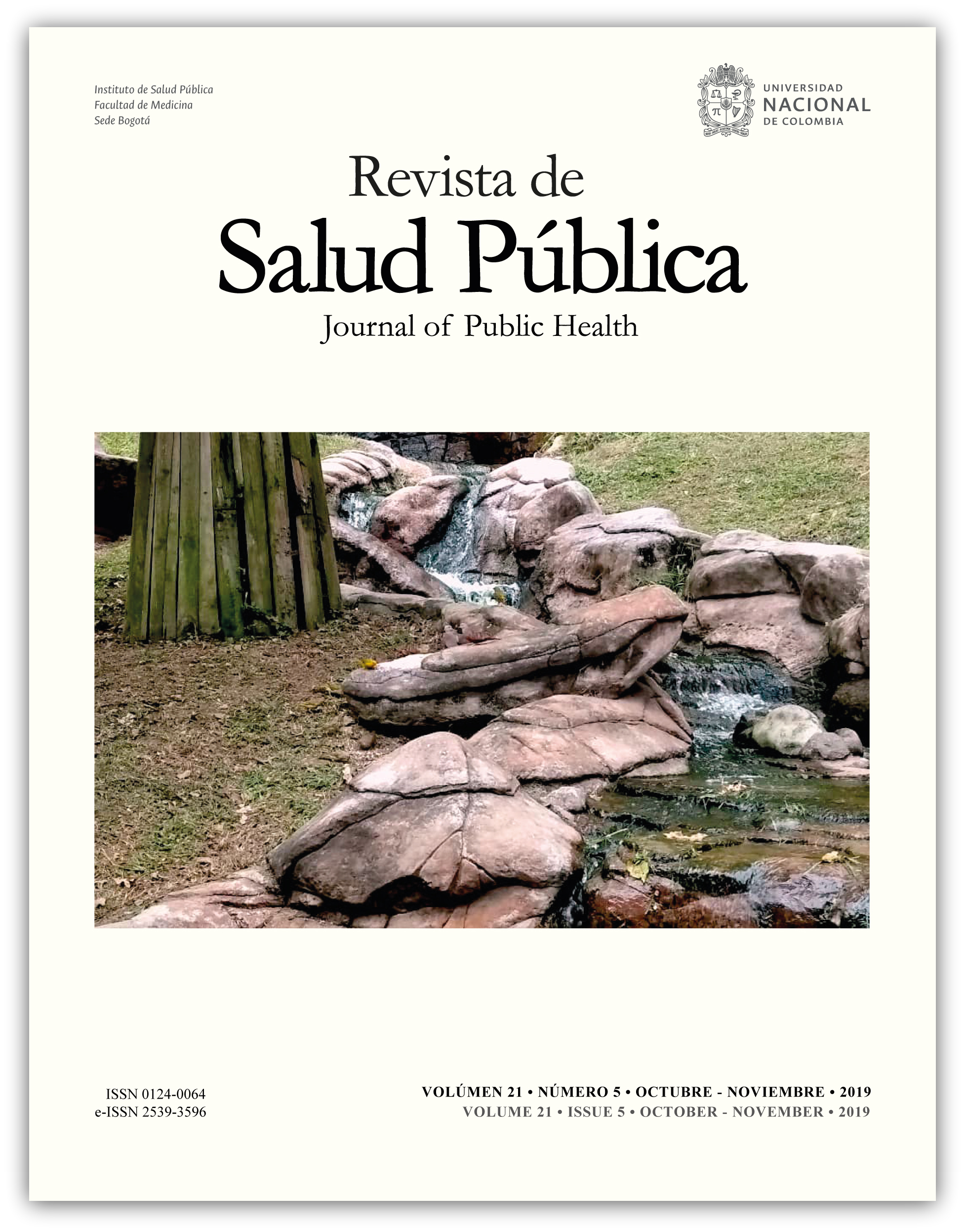Tolerancia al ejercicio y fatiga en mujeres sobrevivientes de cáncer de mama no metastásico
Exercise tolerance and fatigue in women survivors of non-metastatic breast cancer
DOI:
https://doi.org/10.15446/rsap.v21n5.81849Palabras clave:
Fatiga, cáncer de mama, tolerancia al ejercicio (es)Fatigue, breast neoplasms, exercise tolerance (en)
Descargas
El cáncer de mama es el más frecuente a nivel mundial y la principal causa de discapacidad y muerte en mujeres jóvenes en América Latina. Uno de los síntomas más comunes en esta población es la fatiga, reportada entre el 70 y 100% de mujeres sobrevivientes.
Objetivo Describir la relación entre tolerancia al ejercicio y la fatiga, en mujeres sobrevivientes de cáncer de mama no metastásico.
Materiales y Métodos Estudio descriptivo transversal en 40 mujeres entre 18 y 65 años, a partir de una base de datos de una institución de alta complejidad en la ciudad de Cali, Colombia. Se identificó la relación entre fatiga y tolerancia al ejercicio con el
cuestionario “The Functional Assessment of Cancer Therapy FACT-F” y el test de caminata de los 6 minutos (TC6M).
Resultados El 37,5% de las participantes presentaron fatiga relacionada con cáncer de mama; 33% de las mujeres, disnea al final del TC6M; 37,5%, fatiga en miembros inferiores (Borg modificada), y el 42,5% no alcanzó el 80% de la distancia predicha del TC6M.
Conclusión Se encontró una correlación positiva (p 0,000) entre fatiga y tolerancia al ejercicio en mujeres sobrevivientes de cáncer de mama no metastásico.
Breast cancer is the most common type of cancer worldwide, and the leading cause of disability and death in young women in Latin America. One of the most common symptoms in this population is fatigue, reported by 70 to 100% of survivors.
Objective To describe the relationship between exercise tolerance and fatigue in women survivors of non-metastatic breast cancer.
Materials and Methods Cross-sectional descriptive study in 40 women between 18 and 65 years of age, from a database pertaining to a highly complex healthcare institution in the city of Cali, Colombia. The relationship between fatigue and exercise tolerance was identified using the “Functional Assessment of Cancer Therapy FACT-F” questionnaire and the 6-minute walk test (TC6M).
Results 37.5% of the participants presented fatigue related to breast cancer; 33% of women presented dyspnea at the end of the TC6M, 37.5% reported having lower limb fatigue (modified Borg) and 42.5% did not reach 80% of the predicted distance in the TC6M.
Conclusion A positive correlation (p 0.000) was found between fatigue and exercise tolerance in women survivors of non-metastatic breast cancer.
Referencias
Organización Mundial de la Salud. Cáncer de mama: prevención y control [Internet]. OMS; 2018 [cited 2019 Jun 16]. Available from: https://bit.ly/37MhJnj.
Carioli G, Malvezzi M, Rodriguez T, Bertuccio P, Negri E, La Vecchia C. Trends and predictions to 2020 in breast cancer mortality in Europe. Breast. 2017; 36: 89-95. DOI: 10.1016/j.breast.2017.12.004.
Villarreal-Garza C, Aguila C, Magallanes-Hoyos MC, Mohar A, Bargalló E, Meneses A, et al. Breast cancer in young women in Latin America: an unmet, growing burden. Oncologist. 2013; 18(12):1298-306. DOI:10.1634/theoncologist.2013-0321.
Alcaldía de Cali. Cali modelo de atención de cáncer de mama. [Internet]. Cali: Alcaldía Municipal; 2010 [cited 2019 Jun 1]. Available from: https://bit.ly/3fzGMfZ.
Leclerc A, Foidart-Dessalle M, Tomasella M, Coucke P, Devos M, Bruyère O, et al. Multidisciplinary rehabilitation program after breast cancer: benefits on physical function, anthropometry and quality of life. Eur J Phys Rehabil Med. 2017; 53(5):633-42. DOI: 10.23736/s1973-9087.17.04551-8.
Ganz PA, Bower JE. Cancer related fatigue: a focus on breast cancer and Hodgkin's disease survivors. Acta Oncol. 2007; 46:474–479. DOI:10.1080/02841860701367845.
Vaupel P, Mayer A, Briest S, Höckel M. Hypoxia in breast cancer: role of blood flow, oxygen diffusion distances, and anemia in the development of oxygen depletion. Adv Exp Med Biol. 2005; 566:333-42. DOI:10.1007/0-387-26206-7_44.
Bower JE. Cancer-related fatigue--mechanisms, risk factors, and treatments. Nat Rev Clin Oncol. 2014 Oct; 11(10):597-609. DOI: 10.1038/nrclinonc.2014.127.
Reinertsen KV, Engebraaten O, Loge JH, Cvancarova M, Naume B, Wist E, et al. Fatigue During and After Breast Cancer Therapy-A Prospective Study. J Pain Symptom Manage. 2017 Mar; 53(3):551-560. DOI: 10.1016/j.jpainsymman.2016.09.011.
Bower JE, Bak K, Berger A, Breitbart W, Escalante CP, Ganz PA, et al. American Society of Clinical Oncology. Screening, assessment, and management of fatigue in adult survivors of cancer: an American Society of Clinical oncology clinical practice guideline adaptation. J Clin Oncol. 2014 Jun 10; 32(17):1840-50. DOI:10.1200/JCO.2013.53.4495.
Quinten C, Maringwa J, Gotay CC, Martinelli F, Coens C, Reeve BB, et al. Patient self-reports of symptoms and clinician ratings as predictors of overall cancer survival. J Natl Cancer Inst. 2011 Dec 21; 103(24):1851-8. DOI:10.1093/jnci/djr485.
Yellen S, Cella D, Webster K, Blendowski C, Kaplan E. Measuring fatigue and other anemia-related symptoms with the Functional Assessment of Cancer Therapy (FACT) measurement system. J Pain Symptom Manage. 1997 Feb; 13(2):63-74. DOI: 10.1016/s0885-3924(96)00274-6.
Donovan KA, McGinty HL, Jacobsen PB. A systematic review of research using the diagnostic criteria for cancer-related fatigue. Psychooncology. 2013. Apr; 22(4):737-44. DOI:10.1002/pon.3085.
Galiano-Castillo N, Arroyo-Morales M, Ariza-Garcia A, Sánchez-Salado C, Fernández-Lao C, Cantarero-Villanueva I, et al. The Six-Minute Walk Test as a Measure of Health in Breast Cancer Patients. J Aging Phys Act. 2016; 24(4):508-515. DOI:10.1123/japa.2015-0056.
ATS Committee on Proficiency Standards for Clinical Pulmonary Function Laboratories. ATS statement: guidelines for the six-minute walk test. Am J Respir Crit Care Med. 2002 Jul 1; 166(1):111-7. DOI:10.1164/ajrccm.166.1.at1102.
Banzer W, Bernhorster M, Schmidt K, Niederrer D, Lungwitz A, Thiel C, et al. Changes in exercise capacity, quality of life and fatigue in cancer patients during an intervention. Eur J Cancer Care (Engl), 2014; 23(5):624-9. DOI:10.1111/ecc.12201.
Goedendorp MM, Jacobsen PB, Andrykowski MA. Fatigue screening in breast cancer patients: identifying likely cases of cancer-related fatigue. Psycho-oncology. 2016; 25(3):275-81. DOI: 10.1002/pon.3907.
American College of Sport Medicine. Guidelines for Exercise Testing and Prescription. 9th Edition. Baltimore: Wolters Kluwer Health; 2014.
Santos L, Jamami M, Di L, Valéria A, Ronchi C, Arca E, et al. Applicability of reference equations for the six-minute walk test in healthy elderly adults in a municipality of São Paulo. Fisioter Pesq. 2013 [cited 2019 Jun 16]; 00(0):1-5. Available from: https://bit.ly/3fzm7J0.
Enright PL, Sherrill DL. Reference equations for the six-minute walk in healthy adults. Am J Respir Crit Care Med. 1998 Nov; 158(5 Pt 1):1384-7. DOI: 10.1164/ajrccm.158.5.9710086.
FACIT.org. Questionnaires [Internet]. Available from: https://bit.ly/3dahun0.
Van Belle S, Paridaens R, Evers G, et al. Comparison of proposed diagnostic criteria with FACT-F and VAS for cancer-related fatigue: proposal for use as a screening tool. Support Care Cancer. 2005; 13(4):246-254. DOI: 10.1007/s00520-004-0734-y.
Bower JE, Ganz PA, Desmond KA, Rowland JH, Meyerowitz BE, Belin TR. Fatigue in breast cancer survivors: occurrence, correlates, and impact on quality of life. J Clin Oncol. 2000; 18(4):743-53. DOI: 10.1200/JCO.2000.18.4.743.
Ebede CC, Jang Y, Escalante CP. Cancer-Related Fatigue in Cancer Survivorship. Med Clin North Am. 2017 Nov; 101(6):1085-1097. DOI: 10.1016/j.mcna.2017.06.007.
Donovan KA, Jacobsen PB, Small BJ, Munster PN, Andrykowski MA. Identifying clinically meaningful fatigue with the Fatigue Symptom Inventory. J Pain Symptom Manage. 2008 Nov; 36(5):480-7. DOI:10.1016/j.jpainsymman.2007.11.013.
Horneber M, Fischer I, Dimeo F, Rüffer JU, Weis J. Cancer-related fatigue: epidemiology, pathogenesis, diagnosis, and treatment. Dtsch Arztebl Int. 2012 Mar; 109(9):161-71. DOI: 10.3238/arztebl.2012.0161.
Bower JE, Lamkin DM. Inflammation and cancer-related fatigue: mechanisms, contributing factors, and treatment implications. Brain, behavior, and immunity. 2013; 30 Suppl: S48-57. DOI: 10.1016/j.bbi.2012.06.011.
Vincent F, Labourey JL, Leobon S, Antonini MT, Lavau-Denes S, Tubiana-Mathieu N. Effects of a home-based walking training program on cardiorespiratory fitness in breast cancer patients receiving adjuvant chemotherapy: a pilot study. Eur J Phys Rehabil Med. 2013 Jun; 49(3):319-29. PMID: 23480974.
Vardar N, Sener G, Saglam M, Calik E, Arikan H, Inal D, et al. Associations among physical activity, comorbidity, functional capacity, peripheral muscle strength and depression in breast cancer survivors. Asian Pac J Cancer Prev. 2015; 16(2):585-9. DOI: 10.7314/apjcp.2015.16.2.585.
Moreno J, Cruz H, Angarita A. Aplicación de la prueba de caminata de seis minutos y escala de Borg modificada en sujetos con diversos tipos de cáncer. 2013 [cited 2019 Jun 16]:13(1):41-46. DOI: https://bit.ly/3d9dCma.
Rezende LFM, Arnold M, Rabacow FM, Levy RB, Claro RM, Giovannucci E, et al. The increasing burden of cancer attributable to high body mass index in Brazil. Cancer Epidemiol. 2018 Jun; 54:63-70. DOI:10.1016/j.canep.2018.03.006.
Arnold M, Touillaud M, Dossus L, Freisling H, Bray F, Margaritis I, et al. Cancers in France in 2015 attributable to high body mass index. Cancer Epidemiol. 2018; 52:15-19. DOI: 10.1016/j.canep.2017.11.006.
Cómo citar
APA
ACM
ACS
ABNT
Chicago
Harvard
IEEE
MLA
Turabian
Vancouver
Descargar cita
CrossRef Cited-by
1. Liz María Artime Martínez , Fidel Jesús Moreno Cubela, Miguel Romero Ramos, Liudmila Gutiérrez Gacel , Nabia Isabel Vegas Torres . (2023). Characterization of patients with non-palpable breast lesions. AG Salud, 1, p.1. https://doi.org/10.62486/agsalud20231.
Dimensions
PlumX
Visitas a la página del resumen del artículo
Descargas
Licencia
Derechos de autor 2019 Revista de Salud Pública

Esta obra está bajo una licencia internacional Creative Commons Atribución 4.0.
Esta revista provee acceso libre inmediato a su contenido bajo el principio de que hacer disponible gratuitamente investigación al publico apoya a un mayor intercambio de conocimiento global.
Todos los contenidos de esta revista, excepto dónde está identificado, están publicados bajo una Licencia Creative Commons Atribución 4.0.





















